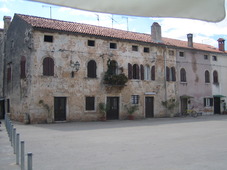to enlarge


or choose the place
from the menu below
 Rome |
 Byzantium |
 Venice |
 Vienna |
 Brioni |
 Smrikve |
 |
 |
In the middle of the square you will note the public well from 1808. This well is together with the one in Vizinada probably one of the most beautiful one in Istria. There is one stone column that have been preserved and probably there were the others columns and a wood made roof to protect people from the sun.
Opposite to the castle’s accommodation tower, on the southern part of the square, there is the Municipal loggia from the 16th century.
The Parish Church of the Holy Assumption is also located on the square, on the eastern side, and was built in the 16th century. The church has a typical Renaissance façade and a Venetian bell tower. The painting “Mary and the Saints Rock and Sebastian” was made by the Venetian painter Palma il Giovane.
 There are two very nice pastel-coloured facades of Renaissance buildings from the 16th
century that would need restructuring investments. One is located on the same side where the Parish Church is located and
the other one with a balcony is located on the side where the Municipal loggia is located.
There are two very nice pastel-coloured facades of Renaissance buildings from the 16th
century that would need restructuring investments. One is located on the same side where the Parish Church is located and
the other one with a balcony is located on the side where the Municipal loggia is located.
Walking trough Svetvincenat you will see many other nice buildings and you will see several wells, in Istrian named “sterna”. Water wells were very important at the time.
 There are two other small churches
located in this southern part of the village. The first one is located in the street that pass near to the castle and the
Municipal loggia and continues towards Vodnjan. This church, located on the first angle of the side street opposite to the
Municipal loggia, is dedicated to St. Anthony the Abbot and dates back into 14th century.
There are two other small churches
located in this southern part of the village. The first one is located in the street that pass near to the castle and the
Municipal loggia and continues towards Vodnjan. This church, located on the first angle of the side street opposite to the
Municipal loggia, is dedicated to St. Anthony the Abbot and dates back into 14th century.
To visit the small church with a typical Istrian porch of St. Catherine that also dates back into 14th century you have to take the side street that pass nearby the castle and the Parish Church and continues towards the village Bokordici. The church is the last building in the village and it also hosts some frescoes paintings. The medieval town walls and its four gates have disappeared over time.
In Svetvincenat’s photo gallery you will find several pictures of this lovely Istrian town.
SVETVINCENAT – HISTORICAL OVERVIEW
Around Svetvincenat there were prehistoric hill fort settlement but the site where Svetvincenat developed dates back in the early Middle Ages and the first time is mentioned in 965. The town in its long history had different names like: San Vincentio Abbazia, Savicente, Savicenti and San Vincenti.
In the 9th and 10th century the Benedictine Monks founded an abbey dedicated to St. Vincent.
It is likely that over the centuries Bishops of Porec became the owner of the feud and in 1177 the Pope Alessandro III confirmed to them that ownership.
In 1209 the Aquileia Patriarchs ruled the area and probably around 1250 they gave it to the family Sergi from Pula, later on named Castropola.
In 1274, in Svetvincenat, Monfiorito Castropola was forced to swear the loyalty to the Aquileia Patriarchs and to Marquis of Istria and he also had to withdraw from Motovun. Castropola ruled over Svetvincenat until 1331 when they were forced to leave Pula.
It is likely that Benedictine Monks left the abbey in 1305 because during that year they gave it to the Templar Knights. In 1314, when the Templar order was suspended by the Pope, the abbey has returned to the Bishops of Porec.
When Castropola left Pula and citizen of Pula decided to join Venice also the dominions of Castropola like Svetvincenat passed to Venice. Castropola, thanks to the alliance with the Aquileia Patriarchs, tried to maintain the rights over Svetvincenat.